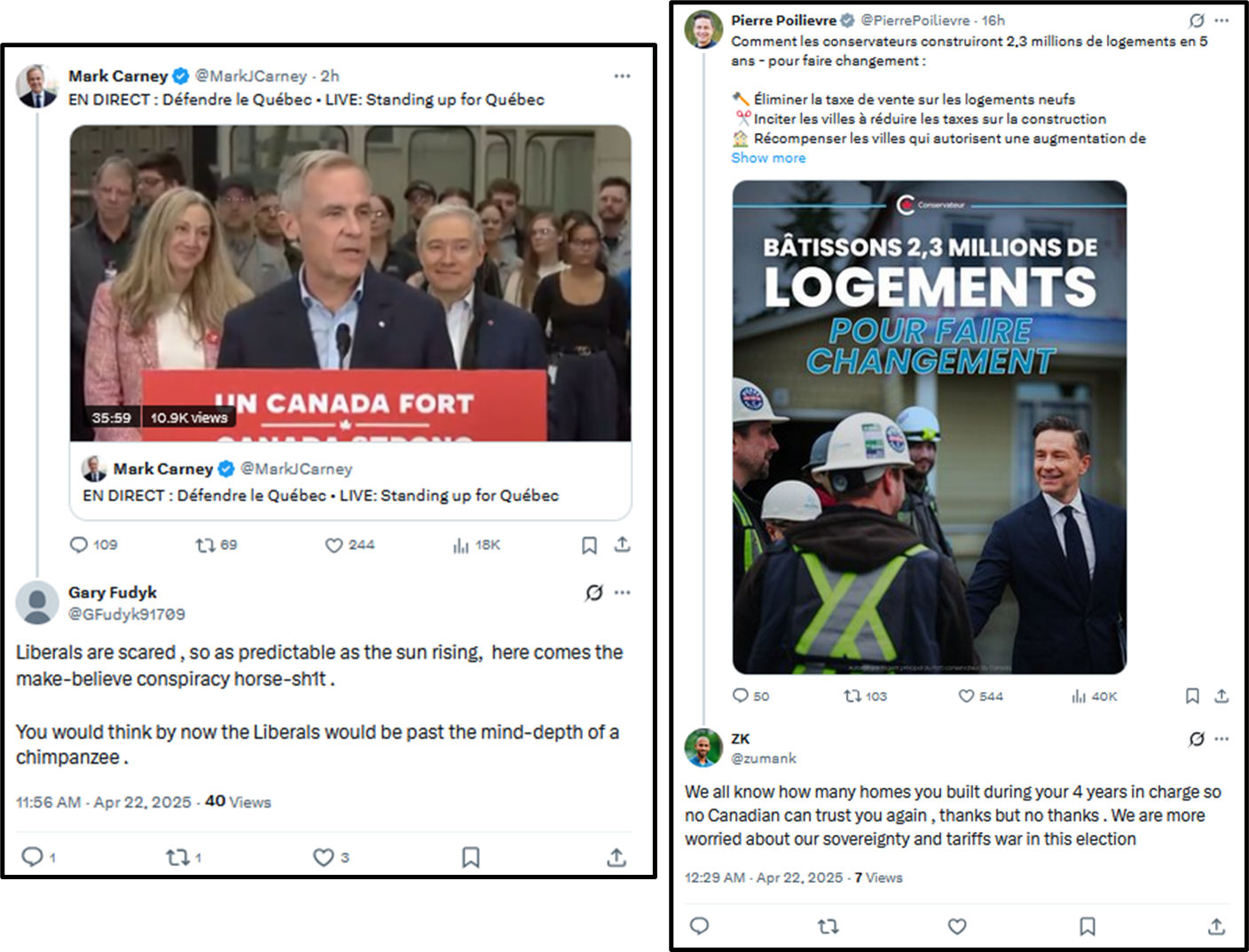Bot-like activity targets Canadian political parties and their leaders ahead of election
Canadian federal election subject to spam messaging from automated X accounts.
Bot-like activity targets Canadian political parties and their leaders ahead of election

BANNER: Liberal Party leader and Prime Minister Mark Carney and Conservative leader and Leader of the Official Opposition Pierre Poilievre are seen during a campaign stop in Edmonton, Alberta, Canada, on April 25, 2025. Layered on top are X posts targeting the two leaders. (Source: Reuters, backdrop; Johnny329130938 and bruce_robi23341, left overlay; aaron5656715545 and FactChecke1907, right overlay)
Highly active bot-like X accounts are amplifying political content in a spam-like manner ahead of the Canadian federal election, frequently replying to posts from federal parties and their leaders. The targeting is not limited to official accounts, but also extends to political accounts and pundits.
Researchers and academic studies have warned of the presence and influence of bots and bot-like accounts on X, highlighting their use for platform manipulation, spam, and overall detrimental impact on online discourse, especially during elections. Notably, X’s platform integrity and authenticity rules list content spam and engagement spam as inauthentic behavior that “disrupts people’s experience.”
During a critical period, such as a federal election, which will be held in Canada on April 28, 2025, the presence and impact of bot-like accounts can be harmful to information and election integrity. Canada has previously highlighted concerns over the threat of information manipulation and disinformation and how it could impact the country’s democratic institutions. A public inquiry, led by Commissioner Marie-Josée Hogue, noted that disinformation “is powerful, it poses a major risk to Canadian democracy. If we do not find ways of addressing it, misinformation and disinformation have the ability to distort our discourse, change our views, and shape our society. In my view it is no exaggeration to say that at this juncture, information manipulation (whether foreign or not) poses the single biggest risk to our democracy. It is an existential threat.”
The threat is evidenced by several online campaigns that targeted Canadian politicians and party candidates. Canada’s Security and Intelligence Threats to Elections Task Force (SITE) linked China to a WeChat campaign that targeted former Liberal leadership candidate Chrystia Freeland. After Mark Carney won the Liberal Party’s leadership seat and was sworn in as prime minister, SITE reported that the same China-linked network pivoted to spreading contrasting narratives targeting Carney. While in 2024, the New Democratic Party (NDP) requested that Elections Canada investigate a bot network that was found to be artificially boosting Conservative leader Pierre Poilievre. The CBC also discovered the use of suspicious bots to amplify narratives on X in the days leading up to and following clashes outside Hindu temples in Canada.
Method
To investigate the phenomenon of spam replies, the DFRLab sampled the official X accounts of the most prominent political parties, the Conservative Party, Liberal Party, NDP, and Bloc Québécois, we also examined accounts belonging to each respective party leader, with a prioritization on English-language accounts, resulting in eight total accounts. The DFRLab collected X posts published between January 1 and April 17, 2025, using the social media listening tool Meltwater Explore and obtained 3,507 posts. We identified 4.2 million total reposts, replies, and quote replies to these 3,000 posts; we were able to collect 2.4 million of these interactions for our dataset.
With this data as the sample, the DFRLab calculated several behavioral metrics for each account that could signal bot activity. Some of the metrics used to rank accounts included a high number of reposts and replies, rapid response times, irregular posting behavior, and the lexical complexity of replies. The DFRLab weighted accounts created in 2025 more heavily, as they were more likely to have been created with the intention of influencing the election.
The DFRLab narrowed down the total of 329,598 accounts from our sample to 150 accounts, with 65 of these 150 accounts created in 2025. The handle names of some of these accounts follow the generic format of a name followed by a long string of numbers, which is a convention favored by X account vendors who create accounts en masse. We acknowledge that the sample of bot-like accounts will include some false positives, to account for extremely active human users, but overall, it is representative of inauthentic activity. From this sample, the DFRLab manually inspected each profile that contained outliers in the behavioral metrics to directly gauge for bot-like content and behavior to be included in the following analysis. At the time of publication, X had restricted some accounts due to “unusual activity.”
Findings
A common theme of these bot-like accounts was the excessive use of repeated images to spam various political accounts. The majority of bot-like accounts targeted the Liberal Party, followed by the Conservative Party, with proportions of about 4 to 1, respectively. Some accounts that targeted the Liberals also targeted the NDP, and none targeted the Bloc Québécois, which was likely underrepresented due to our sample focusing on English-language accounts. The anti-Liberal bot-like accounts frequently included graphics featuring Prime Minister Carney in their spam messages. The DFRLab did not find clear signs of coordination between these accounts.
The common narratives targeting Carney alleged that he represents a continuation of former Prime Minister Justin Trudeau’s policies, he is loyal to China, he has connections to Jeffrey Epstein and Ghislaine Maxwell (a narrative that emerged after an AI-generated photo depicted Carney with Maxwell) and noted his involvement with the World Economic Forum, which holds an annual meeting in Davos that has attracted conspiracy theories.
While the bot-like accounts relied heavily on images, they did not appear to be creating their own graphics. Instead, they amplified graphics that originated elsewhere, such as from the right-wing group Canada Proud or the official account of Conservative leader Pierre Poilievre. In one example on April 11, 2025, after Carney paused his campaign to address tariffs imposed by US President Donald Trump, Canada Proud posted a graphic claiming that the pause was due to revelations of alleged connections between Carney and China. The account @NorthernSlide, which has been flooding comment sections with repetitive anti-Liberal Party visuals since well before the election period, began using the graphic on the same day and posted it in replies, often publishing posts at similar times. The account posted the graphic at least forty times between April 11 and April 23, with most of the posts being published between April 11 and April 14.

The DFRLab also observed bot-like activity targeting the Conservative Party and Poilievre, albeit at a lower volume than those focused on Carney.

Some of the replies were copypastas that were potentially generated by AI. For example, two accounts, @GFudyk91709 and @zumank, frequently replied to posts with the same text that included an extra space before the punctuation mark, which has been previously documented as an artifact leftover from text generated by older large language models.

Conclusion
Canada’s snap election is taking place amid a historic rift in relations with the United States, sparked by a trade war and threats of annexation from US President Trump. Canada has seen a record number of votes cast in advance polls, demonstrating how Canadians perceive this election as a pivotal moment for the country. At the same time, such high-stakes environments are often fertile ground for malign actors who seek to manipulate information environments before and after votes are cast, and using bots and bot-like behavior is one of the methods that can pollute what users see by artificially inflating the presence of certain content.
Cite this case study:
DFRLab, “Bot-like activity targets Canadian political parties and their leaders ahead of election,” Digital Forensic Research Lab (DFRLab), April 25, 2024, https://dfrlab.org/2025/04/25/bot-like-activity-targets-canadian-political-parties-and-their-leaders-ahead-of-election/.

